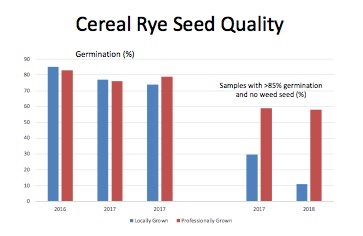
Cover crops are nothing new, but their relationship to a changing climate might be new to many farmers.

Cover crops are nothing new, but their relationship to a changing climate might be new to many farmers.
Indiana growers have shown increased interest in utilizing cover crops in our corn and soybean production systems over the last decade. Concurrently, there has also been increased utilization of soil residual herbicides to help manage herbicide-resistant weeds such as marestail (horseweed), waterhemp, and giant ragweed in our corn and soybean production systems. Soil residual herbicides can remain active in the soil for a period of weeks to months after application. The length of time a residual herbicide remains biologically active in the soil is influenced by soil texture, soil pH, organic matter, rainfall, and temperature. Since these factors will vary from field to field, definitive time intervals of residual herbicide activity can be difficult to predict. The use of residual herbicides in our corn and soybean production systems may interfere with establishment of fall seeded cover crops under certain conditions. Unfortunately, many of the species being used for cover crops[Read More…]

Indiana growers have shown increased interest in utilizing cover crops in our corn and soybean production systems over the last decade. Concurrently, there has also been increased utilization of soil residual herbicides to help manage herbicide-resistant weeds such as marestail (horseweed), waterhemp, and giant ragweed in our corn and soybean production systems. Soil residual herbicides can remain active in the soil for a period of weeks to months after application. The length of time a residual herbicide remains biologically active in the soil is influenced by soil texture, soil pH, organic matter, rainfall, and temperature. Since these factors will vary from field to field, definitive time intervals of residual herbicide activity can be difficult to predict. The use of residual herbicides in our corn and soybean production systems may interfere with establishment of fall seeded cover crops under certain conditions. Unfortunately, many of the species being used for cover crops[Read More…]
During this incredibly challenging 2019 planting season, Indiana corn and soybean farmers are faced with difficult planting decisions. We have passed the June 5 date to begin electing prevented planting on corn acres, and the June 20 soybean date is quickly approaching. With more rain in the forecast, we could see substantial acreage across Indiana in this prevented planting scenario. Policy and market dynamics are further complicating these decisions. For farmers continuing to face delays due to saturated soils, prevented planting may appear to be a rather sour outcome in what is already a challenging agricultural economy. Can we turn these proverbial lemons into lemonade? Farmers with livestock or neighboring livestock operations in need of forage could look at generating some revenue from these prevented planting acres by seeding forage-type cover crops that could be harvested or grazed starting November 1, and still provide a full prevented planting payment (see[Read More…]
Planting cover crops on prevented planting acres can be a good way to improve soil health after the excessive water this spring and can help with weed control on otherwise fallow land.

Cover crops have increased in interest and acres planted substantially in the past decade. Indiana has now had three consecutive years of over one million acres of cover crops planted.
© 2024 Purdue University | An equal access/equal opportunity university | Copyright Complaints | Maintained by Pest&Crop newsletter
If you have trouble accessing this page because of a disability, please contact Pest&Crop newsletter at luck@purdue.edu.